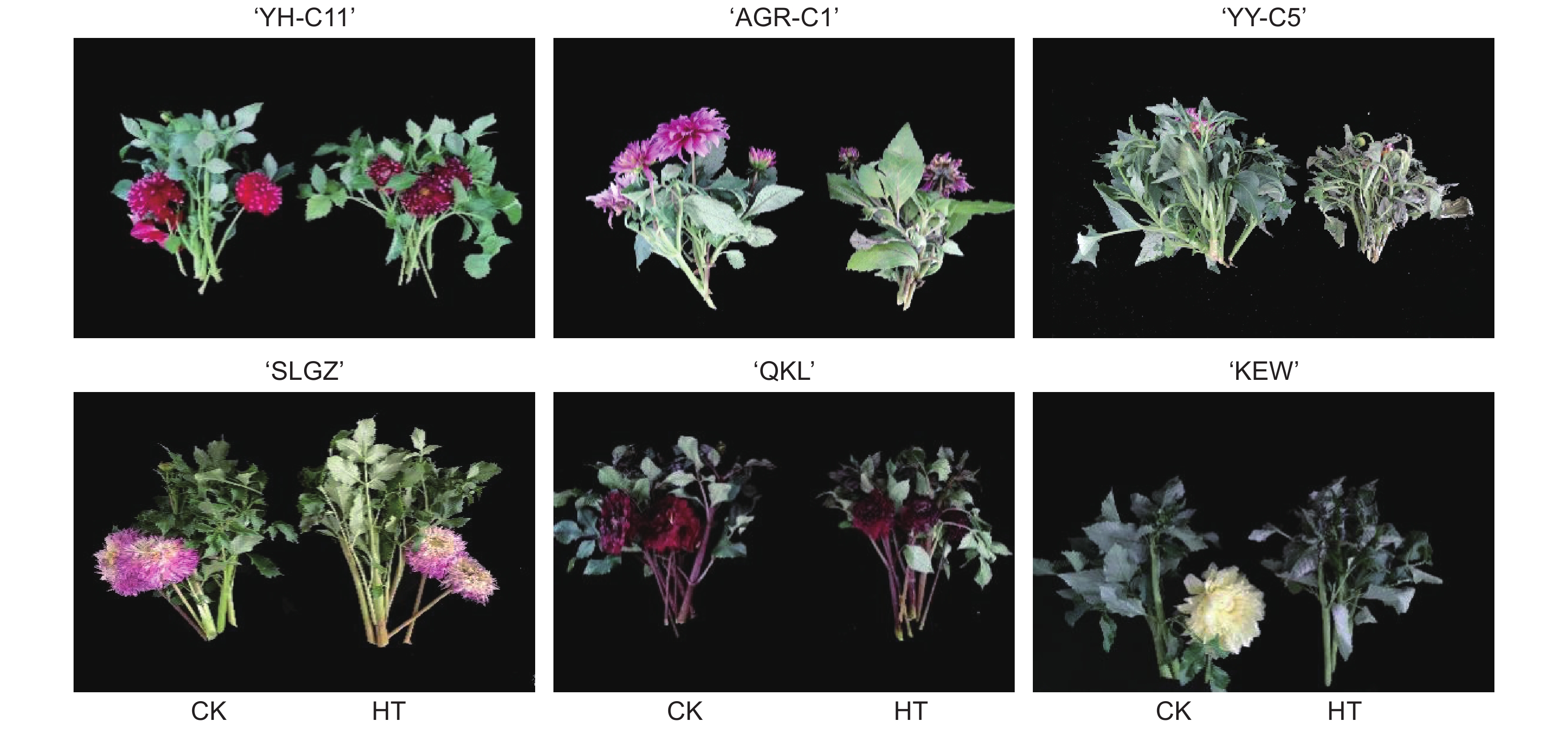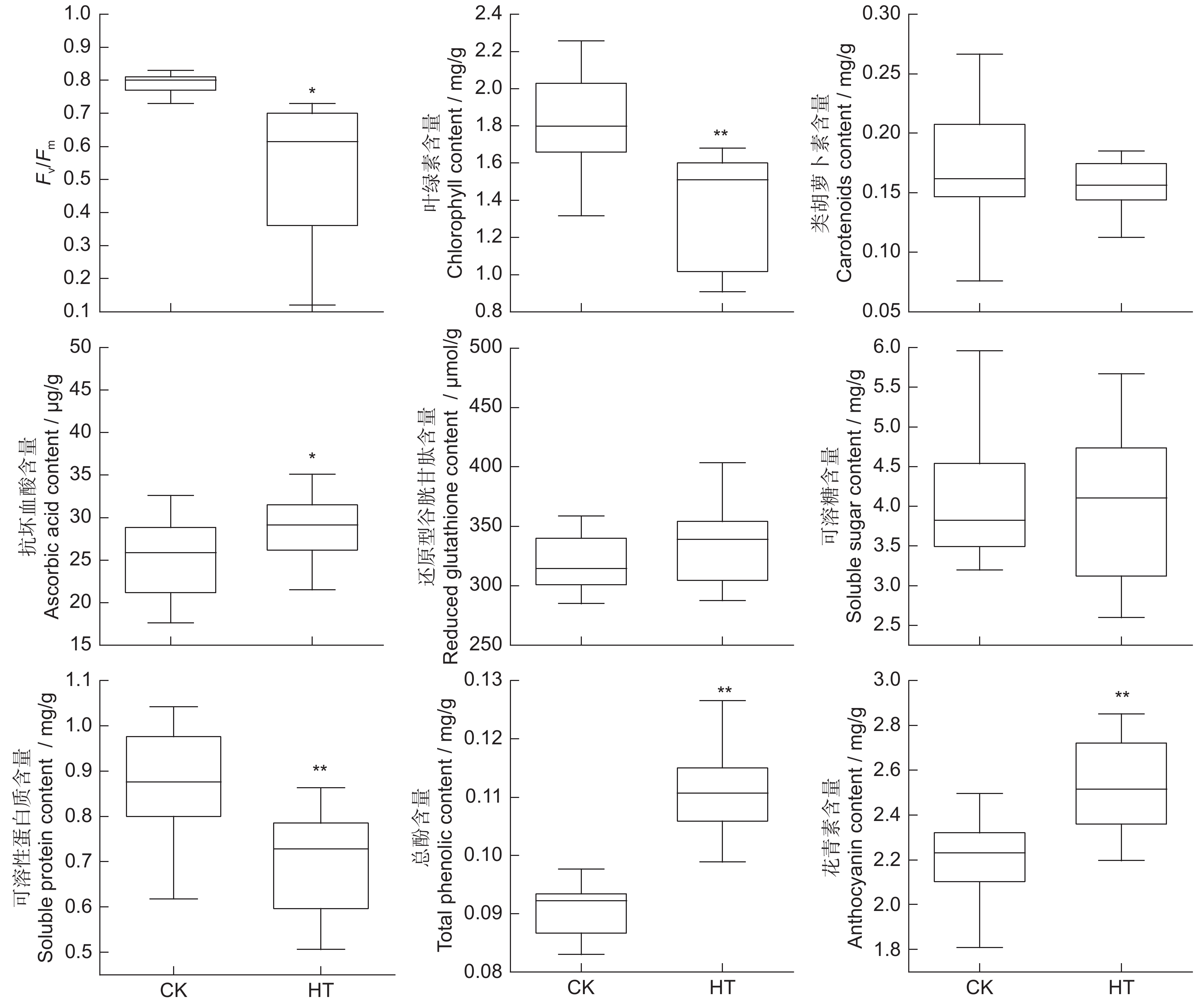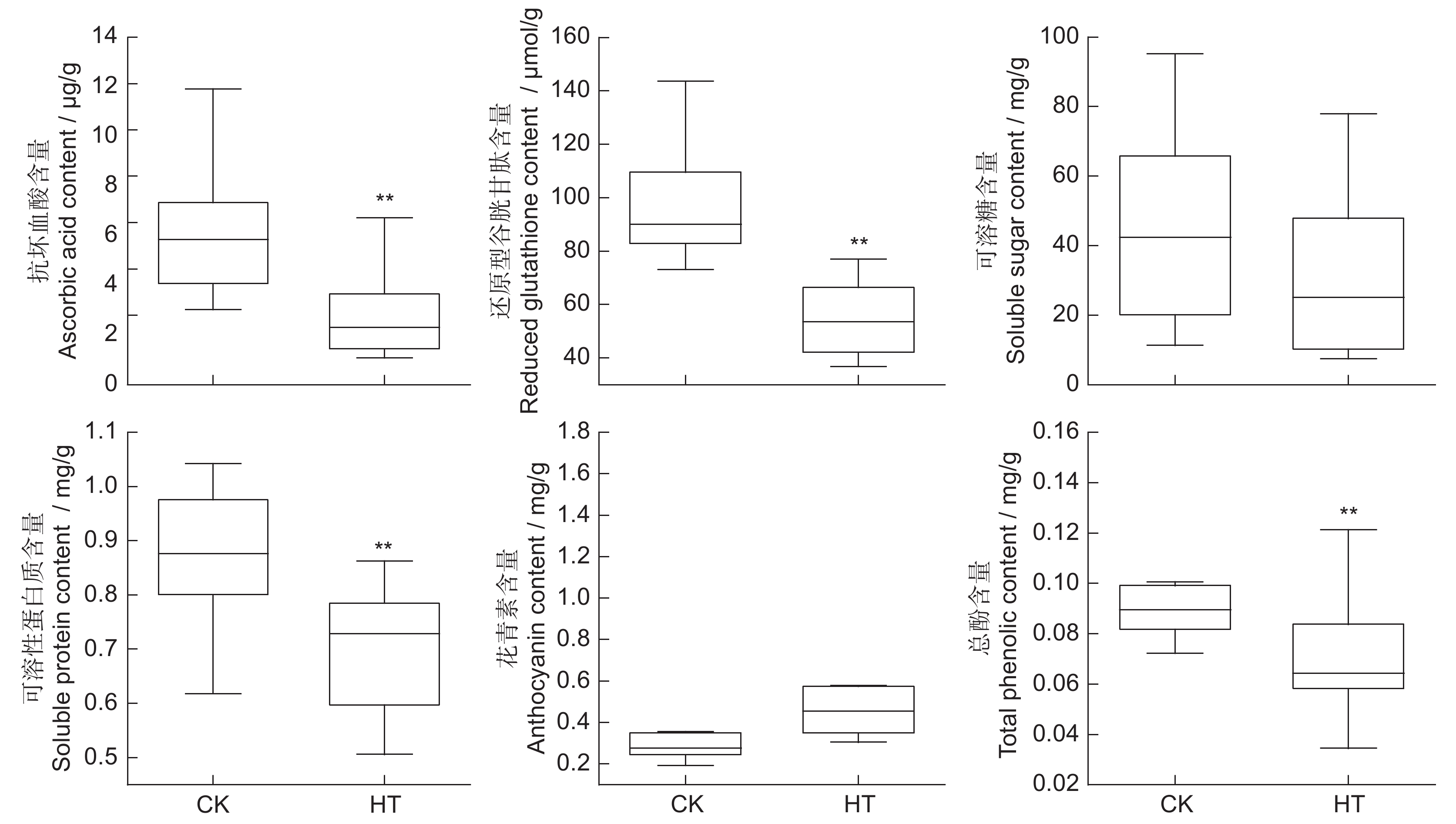Comprehensive evaluation of the physiological response and heat tolerance of six Dahlia pinnata Cav. cultivars to high-temperature stress
-
摘要:
本文以6个大丽花(Dahlia pinnata Cav.)品种为材料,研究高温胁迫处理(40℃/35℃,14 h 昼/10 h 夜)2 d对其形态和生理指标的影响,应用相关性分析、主成分分析和隶属函数法计算耐热性综合评价值D,并用逐步回归分析法筛选鉴定大丽花耐热性指标。结果显示:(1)高温胁迫后,叶片中Fv/Fm值和叶绿素含量均下降;抗坏血酸和还原型谷胱甘肽含量在叶片中上升,在茎中下降;可溶性糖和可溶性蛋白含量在叶片和茎中均下降;总酚含量在叶片中显著上升,在茎中显著下降;花青素含量在叶片和茎中均上升。(2)基于耐热性综合评价值D,6个品种中,‘SLGZ’耐热性较强;‘KEW’、‘QKL’和‘YH-C11’耐热性中等;‘AGR-C1’和‘YY-C5’耐热性弱。(3)回归分析结果表明,叶片的半致死温度和叶绿素含量、茎的可溶性蛋白和抗坏血酸含量、热害指数可作为鉴定大丽花耐热性的指标。
Abstract:Six cultivars of Dahlia pinnata Cav. were used to investigate the effects of high-temperature stress (40℃/35℃, 14 h/10 h (day/night), 2 d) on morphological and physiological indices. Correlation analysis, principal component analysis, and membership function analysis were applied to calculate the comprehensive evaluation value D for heat resistance and stepwise regression analysis was used to screen indicators of heat tolerance. Results showed: (1) After high-temperature stress, the Fv / Fm value and chlorophyll content decreased in leaves. Ascorbic acid and reduced glutathione contents increased in leaves and decreased in stems, while soluble sugar and soluble protein contents decreased in both leaves and stems. Total phenol content increased significantly in leaves and decreased significantly in stems, while anthocyanin content increased in leaves and stems. (2) According to the comprehensive evaluation value D for heat resistance, among the six varieties, ‘SLGZ’ showed the strongest heat resistance, ‘KEW’, ‘QKL’, and ‘YH-C11 showed medium heat resistance, and ‘AGR-C1’ and ‘YY-C5’ showed the weakest heat resistance. (3) Regression analysis indicated that semi-lethal temperature and chlorophyll content of leaves, soluble protein and ascorbic acid content of stems, and the heat damage index could be used as indicators of heat tolerance in dahlias.
-
Keywords:
- Dahlia pinnata /
- High-temperature stress /
- Heat tolerance /
- Comprehensive evaluation
-
-
表 1 6个供试大丽花品种基本信息
Table 1 Information on six Dahlia pinnata cultivars
品种
Variety来源
Origin‘YH-C11’ 广州市怡华园艺有限公司 ‘AGR-C1’ 云南艾格瑞农业科技有限公司 ‘YY-C5’ 上海源怡种苗公司 ‘SLGZ’ 北京中世花卉有限公司 ‘QKL’ 北京林业大学 ‘KEW’ 甘肃 表 2 大丽花形态指标和热害指数
Table 2 Dahlia pinnata morphology and heat damage indices
品种
Cultivar枝条长度
Branch length / cm枝条粗度
Branch diameter / mm热害指数
Heat damage index / %排序
Order‘YH-C11’ 41.83 ± 0.48cd 8.62 ± 0.17b 20.00 2 ‘AGR-C1’ 26.67 ± 0.99ed 7.33 ± 0.23c 53.33 4 ‘YY-C5’ 21.50 ± 1.45e 6.08 ± 0.14d 80.00 6 ‘SLGZ’ 42.02 ± 0.61b 12.62 ± 0.47a 13.33 1 ‘QKL’ 48.17 ± 0.55c 9.50 ± 0.29b 33.33 3 ‘KEW’ 46.58 ± 0.84a 17.33 ± 0.80a 60.00 5 注:同列不同小写字母表示不同品种在0.05水平上差异显著。 Note:Different lowercase letters in the same column indicate significant difference at 0.05 level. 表 3 叶和茎的Logistic 方程及半致死温度
Table 3 Logistic equations and LT50 values of leaves and stems
测定部位
Measurement site品种
Culticar回归方程
Logistic equation决定系数
R2半致死温度
LT50 / ℃叶片 ‘YH-C11’ Y = 71.80/(1 + e−(49.34−x)) + 27.21 0.996 49.34 ‘AGR-C1’ Y = 75.56/(1 + e−(47.79−x)) + 15.07 0.996 47.79 ‘YY-C5’ Y = 64.01/(1 + e−(46.07−x)) + 37.29 0.990 46.07 ‘SLGZ’ Y = 75.19/(1 + e−(49.65−x)) + 27.21 0.997 49.65 ‘QKL’ Y = 68.21/(1 + e−(50.38−x)) + 22.58 0.998 50.38 ‘KEW’ Y = 67.11/(1 + e−(48.80−x)) + 20.41 0.999 48.80 茎 ‘YH-C11’ Y = 62.86/(1 + e−(54.49−x)) + 13.48 0.989 54.49 ‘AGR-C1’ Y = 49.24/(1 + e−(51.60−x)) + 24.24 0.993 51.60 ‘YY-C5’ Y = 43.56/(1 + e−(51.21−x)) + 20.60 0.997 51.21 ‘SLGZ’ Y = 72.52/(1 + e−(52.35−x)) + 12.66 0.990 52.35 ‘QKL’ Y = 65.67/(1 + e−(55.10−x)) + 82.44 0.967 55.10 ‘KEW’ Y = 66.65/(1 + e−(52.63−x)) + 30.55 0.998 52.63 表 4 半致死温度、热害指数和各指标相对值的相关性分析
Table 4 Correlation analysis of relative values of LT50, HI, and each index
指标
IndexLT50
(L)LT50
(S)Fv/Fm
(L)Carotenoids (L) Chl
(L)AsA
(L)AsA
(S)GSH
(L)GSH
(S)SS
(L)SS
(S)SP
(L)SP
(S)TP
(L)TP
(S)Anthocyanin
(L)Anthocyanin
(S)HI LT50 (L) 1 TL50 (S) 0.81 1 Fv/Fm (L) 0.976** 0.709 1 Carotenoids (L) −0.779 −0.737 −0.710 1 Chl (L) 0.419 0.109 0.475 −0.492 1 AsA (L) 0.751 0.967** 0.615 −0.644 0.048 1 AsA (S) 0.404 0.041 0.506 0.134 0.476 0.062 1 GSH (L) −0.067 0.088 −0.248 −0.164 −0.432 0.232 −0.604 1 GSH (S) −0.274 −0.490 −0.064 0.303 0.234 −0.669 0.238 −0.818* 1 SS (L) 0.590 0.356 0.660 0.039 0.060 0.350 0.822* −0.436 0.068 1 SS (S) 0.457 −0.100 0.495 −0.319 0.581 −0.087 0.470 0.066 −0.033 0.250 1 SP (L) 0.547 0.453 0.412 −0.355 0.276 0.622 0.356 0.432 −0.783 0.305 0.490 1 SP (S) 0.256 −0.153 0.389 −0.273 0.918** −0.266 0.523 −0.636 0.577 0.108 0.578 −0.039 1 TP (L) −0.185 −0.395 0.016 0.332 0.392 −0.532 0.500 −0.946** 0.932** 0.242 −0.014 −0.574 0.667 1 TP (S) 0.784 0.643 0.785 −0.908* 0.369 0.478 −0.086 −0.012 −0.021 0.117 0.330 0.082 0.300 −0.135 1 Anthocyanin (L) 0.108 −0.080 0.213 −0.409 0.798 −0.248 0.074 −0.548 0.600 −0.269 0.238 −0.321 0.863* 0.590 0.421 1 Anthocyanin (S) −0.832* −0.775 −0.811 0.953** −0.458 −0.629 0.023 0.069 0.099 −0.142 −0.236 −0.186 −0.317 0.131 −0.964** −0.446 1 HI −0.833* −0.609 −0.876* 0.335 −0.112 −0.551 −0.623 0.293 0.038 −0.911* −0.313 −0.332 −0.108 −0.057 −0.500 0.160 0.505 1 注: *和**分别表示在0.05和0.01水平上差异显著。L:叶片;S:茎;Fv/Fm:最大荧光量子效率;Chl:叶绿素含量;Carotenoids:类胡萝卜素含量;AsA:抗坏血酸含量;GSH:还原型谷胱甘肽含量;SS:可溶性糖含量;SP:可溶性蛋白质含量;Anthocyanin:花青素含量;TP:总酚含量;HI:热害指数。
Notes: * and ** are significantly different at 0.05 and 0.01 probability levels, respectively. L: Leaf; S: Stem; Fv/Fm: Maximum fluorescence quantum efficiency; Chl: Chlorophyll content; Carotenoids: Carotenoid content; AsA: Ascorbic acid content; GSH: Reduced glutathione content; SS: Soluble sugar content; SP: soluble protein content; Anthocyanin: Anthocyanin content; TP: Total phenolic content.表 5 各指标主成分的特征向量及贡献率
Table 5 Eigenvector and contribution rates of principal components of all indices
主成分
Principle factorP-1 P-2 P-3 P-4 特征值 7.24 5.19 2.82 1.90 贡献率 / % 40.25 28.84 15.68 10.56 累计贡献率 / % 40.25 69.09 84.77 95.33 特征向量 LT50 (L) 0.37 −0.03 0.05 −0.02 Fv/Fm (L) 0.36 0.06 0.08 −0.05 Anthocyanin (S) −0.32 −0.01 0.26 0.17 Carotenoids(L) −0.31 0.06 0.33 0.01 LT50 (S) 0.30 −0.18 −0.02 −0.25 TP (S) 0.30 0.01 −0.27 −0.17 HI −0.29 −0.02 −0.32 0.17 AsA (L) 0.27 −0.24 0.04 −0.14 TP (L) −0.05 0.42 0.09 −0.16 GSH (L) −0.09 0.39 −0.02 −0.23 GSH (S) −0.04 −0.38 −0.15 0.25 SP(S) 0.13 0.38 −0.12 0.23 Anthocyanin (L) 0.08 0.33 −0.36 0.02 Chl (L) 0.19 0.27 −0.17 0.32 SS (L) 0.19 0.08 0.49 −0.10 AsA (S) 0.15 0.23 0.42 0.18 SS (S) 0.17 0.12 0.02 0.53 SP (L) 0.20 −0.20 0.15 0.45 注: P-1:主成分1;P-2:主成分2;P-3:主成分3;P-3:主成分4。缩写同表4。
Notes: P-1: Principle factor 1; P-2: Principle factor 2; P-3: Principle factor 3; P-3: Principle factor 3. Abbreviations are the same as those given in Table 4.表 6 不同品种大丽花的综合指标值(C)、权重、U(Xj)、D 值及VP值
Table 6 Comprehensive index (C), index weight, U(Xj), D-value, and predicted value of each cultivar
品种
CultivarC1 C2 C3 C4 U(X1) U(X2) U(X3) U(X4) D VP 排序
Order‘YH-C11’ 0.36 0.02 0.41 −1.95 0.73 0.56 0.65 0.00 0.59 0.58 4 ‘AGR-C1’ −0.70 −0.49 −0.41 −0.01 0.35 0.37 0.38 0.70 0.40 0.38 5 ‘YY-C5’ −1.65 −0.21 0.31 0.31 0.00 0.48 0.62 0.82 0.34 0.31 6 ‘SLGZ’ 0.57 0.97 1.46 0.81 0.81 0.91 1.00 1.00 0.89 0.89 1 ‘QKL’ 1.10 −1.51 −0.22 0.63 1.00 0.00 0.44 0.93 0.60 0.59 3 ‘KEW’ 0.33 1.22 −1.55 0.22 0.72 1.00 0.00 0.79 0.69 0.67 2 权重 / % 42.22 30.25 16.45 11.08 注: C1:综合指标值1;C2:综合指标值2;C3:综合指标值3;C4:综合指标值4。U(X1):隶属函数值1;U(X2):隶属函数值2;U(X3):隶属函数值3;U(X4):隶属函数值4。D:耐热性综合评价值。VP:预测值。
Notes: C1: Comprehensive index value 1; C2: Comprehensive index value 2; C3: Comprehensive index value 3; C4: Comprehensive index value 4. U(X1): Membership function value 1; U(X2): Membership function value 2; U(X3): Membership function value 3; U(X4): Membership function value 4. D: Temperature resistance comprehensive evaluation values. VP: Predicted value. -
[1] Kumari P,Singh S,Yadav S. Analysis of thermotolerance behaviour of five chickpea genotypes at early growth stages[J]. Braz J Bot,2018,41 (3):551−565. doi: 10.1007/s40415-018-0484-6
[2] 刘文英. 植物逆境与基因[M]. 北京: 北京理工大学出版社, 2015: 103−105. [3] Singh B,Kukreja S,Goutam U. Impact of heat stress on potato (Solanum tuberosum L.):present scenario and future opportunities[J]. J Hortic Sci Biotechnol,2020,95 (4):407−424. doi: 10.1080/14620316.2019.1700173
[4] 逯久幸,苗润田,王司琦,赵鹏飞,张开明,等. 低温胁迫下秋菊叶片光系统特性分析[J]. 植物生理学报,2022,58(2):425−434. doi: 10.13592/j.cnki.ppj.2021.0065 Lu JX,Miao RT,Wang SQ,Zhao PF,Zhang KM,et al. Analysis of photosystem features in autumn Chrysanthemum leaves under low temperature stress[J]. Plant Physiology Journal,2022,58 (2):425−434. doi: 10.13592/j.cnki.ppj.2021.0065
[5] Li CJ,Han YY,Hao JH,Qin XX,Liu CJ,et al. Effects of exogenous spermidine on antioxidants and glyoxalase system of lettuce seedlings under high temperature[J]. Plant Signal Behav,2020,15 (12):1824697. doi: 10.1080/15592324.2020.1824697
[6] Jahan MS,Shu S,Wang Y,Chen Z,He MM,et al. Melatonin alleviates heat-induced damage of tomato seedlings by balancing redox homeostasis and modulating polyamine and nitric oxide biosynthesis[J]. BMC Plant Biol,2019,19 (1):414. doi: 10.1186/s12870-019-1992-7
[7] 唐凯明. 四季桂叶绿素荧光和AsA-GSH循环对酸雨和高温的响应[D]. 杭州: 浙江农林大学, 2019: 4−7. [8] Wassie M,Zhang WH,Zhang Q,Ji K,Chen L. Effect of heat stress on growth and physiological traits of alfalfa (Medicago sativa L. ) and a comprehensive evaluation for heat tolerance[J]. Agronomy,2019,9 (10):597. doi: 10.3390/agronomy9100597
[9] Karimi R,Amini H,Ghabooli M. Root endophytic fungus Piriformospora indica and zinc attenuate cold stress in grapevine by influencing leaf phytochemicals and minerals content[J]. Sci Horticu,2022,293:110665. doi: 10.1016/j.scienta.2021.110665
[10] 张萍萍. 大丽花耐热性及化学调控机理的基础研究[D]. 苏州: 苏州大学, 2016: 24−72. [11] Zhao CL,Guan H,Yuan XF,Li XX,Gao L,et al. Effects of paclobutrazol on physiological parameters of dahlia under heat stress[J]. Agric Biotechnol,2018,7 (5):67−70.
[12] 管华. 大丽花高温胁迫响应机制的蛋白质组学研究[D]. 苏州: 苏州大学, 2018: 26−86. [13] 吴强盛. 植物生理学实验指导[M]. 北京: 中国农业出版社, 2018: 104−106, 138−141. [14] Mehrtens F,Kranz H,Bednarek P,Weisshaar B. The Arabidopsis transcription factor MYB12 is a flavonol-specific regulator of phenylpropanoid biosynthesis[J]. Plant Physiol,2005,138 (2):1083−1096. doi: 10.1104/pp.104.058032
[15] 李玲. 植物生理学模块实验指导[M]. 北京: 科学出版社, 2009: 48−57, 100−102. [16] 凌瑞,戴中武,代晓雨,吴春梅,翟俊文,等. 8个绣球品种耐热性综合评价与耐热指标筛选[J]. 热带作物学报,2021,42(8):2209−2218. doi: 10.3969/j.issn.1000-2561.2021.08.012 Ling R,Dai ZW,Dai XY,Wu CM,Zhai JW,et al. Evaluation of heat tolerance and screening the index for the as-sessment of heat tolerance in cultivars of hydrangea[J]. Chinese Journal of Tropical Crops,2021,42 (8):2209−2218. doi: 10.3969/j.issn.1000-2561.2021.08.012
[17] 吴瑞香,杨建春,王利琴,郭秀娟. 应用多元分析法综合评价胡麻材料抗旱适应性[J]. 作物杂志,2018(5):10−16. doi: 10.16035/j.issn.1001-7283.2018.05.002 Wu RX,Yang JC,Wang LQ,Guo XJ. Evaluation of the adaptability of flax drought resistance based on multiple statistics analysis[J]. Crops,2018 (5):10−16. doi: 10.16035/j.issn.1001-7283.2018.05.002
[18] 朱亚迪,王慧琴,王洪章,任昊,吕建华,等. 不同夏玉米品种大喇叭口期耐热性评价和鉴定指标筛选[J]. 作物学报,2022,48(12):3130−3143. Zhu YD,Wang HQ,Wang HZ,Ren H,Lü JH,et al. Evaluation and identification index of heat tolerance in different summer maize varieties at V12 stage[J]. Acta Agronomica Sinica,2022,48 (12):3130−3143.
[19] Weng JY,Li PL,Rehman A,Wang LK,Gao X,et al. Physiological response and evaluation of melon (Cucumis melo L.) germplasm resources under high temperature and humidity stress at seedling stage[J]. Sci Horticu,2021,288:110317. doi: 10.1016/j.scienta.2021.110317
[20] 闫旭,张心艺,李阳宁,李铁华,胡胜男. 复层林对闽楠幼树生长、叶片形态和光合特性的影响[J]. 植物科学学报,2022,40(4):553−564. doi: 10.11913/PSJ.2095-0837.2022.40553 Yan X,Zhang XY,Li YN,Li TH,Hu SN. Effects of unevenly aged two-layer mixed forest on growth,leaf morphology,and photosynthetic characteristics of Phoebe bournei (Hemsl. ) Yang saplings[J]. Plant Science Journal,2022,40 (4):553−564. doi: 10.11913/PSJ.2095-0837.2022.40553
[21] Hu SS,Ding YF,Zhu C. Sensitivity and responses of chloroplasts to heat stress in plants[J]. Front Plant Sci,2020,11:375. doi: 10.3389/fpls.2020.00375
[22] Huang C,Tian YL,Zhang BB,Hassan MJ,Li Z,et al. Chitosan (CTS) alleviates heat-induced leaf senescence in creeping bentgrass by regulating chlorophyll metabolism,antioxidant defense,and the heat shock pathway[J]. Molecules,2021,26 (17):5337. doi: 10.3390/molecules26175337
[23] 汪雨茜,何伟伟,李大婧,包怡红,刘春泉,等. 不同浓度NaCl处理对发芽玉米中类胡萝卜素富集的影响[J]. 现代食品科技,2019,35(4):61−69. doi: 10.13982/j.mfst.1673-9078.2019.4.010 Wang YX,He WW,Li DJ,Bao YH,Liu CQ,et al. Effects of different concentrations of NaCl treatment on carotenoid enrichment in germinated corn[J]. Modern Food Science and Technology,2019,35 (4):61−69. doi: 10.13982/j.mfst.1673-9078.2019.4.010
[24] Xiao MG,Li ZX,Zhu L,Wang JY,Zhang B,et al. The multiple roles of ascorbate in the abiotic stress response of plants:antioxidant,cofactor,and regulator[J]. Front Plant Sci,2021,12:598173. doi: 10.3389/fpls.2021.598173
[25] 韩键,白云赫,朱旭东,郑婷,张克坤,等. 植物谷胱甘肽应答非生物胁迫的分子机制[J]. 分子植物育种,2020,18(5):1672−1680. doi: 10.13271/j.mpb.018.001672 Han J,Bai YH,Zhu XD,Zheng T,Zhang KK,et al. Molecular mechanism of glutathione response to abiotic stress in plants[J]. Molecular Plant Breeding,2020,18 (5):1672−1680. doi: 10.13271/j.mpb.018.001672
[26] Li Y,Liu M,Yang XL,Zhang Y,Hui HT,et al. Multi-walled carbon nanotubes enhanced the antioxidative system and alleviated salt stress in grape seedlings[J]. Sci Hortic,2022,293:110698. doi: 10.1016/j.scienta.2021.110698
[27] Altaf MA,Shahid R,Ren MX,Naz S,Altaf MM,et al. Melatonin improves drought stress tolerance of tomato by modulating plant growth,root architecture,photosynthesis,and antioxidant defense system[J]. Antioxidants,2022,11 (2):309. doi: 10.3390/antiox11020309
[28] 赵森,于江辉,肖国樱. 高温胁迫对爪哇稻剑叶光合特性和渗透调节物质的影响[J]. 生态环境学报,2013,22(1):110−115. doi: 10.3969/j.issn.1674-5906.2013.01.021 Zhao S,Yu JH,Xiao GY. Effects of high temperature stress on the photosynthesis and osmoregulation substances of flag leaves in Oryza stavia L. ssp. javanica[J]. Ecology and Environmental Sciences,2013,22 (1):110−115. doi: 10.3969/j.issn.1674-5906.2013.01.021
[29] Rivero RM,Ruiz JM,Romero L. Can grafting in tomato plants strengthen resistance to thermal stress?[J]. J Sci Food Agric,2003,83 (13):1315−1319. doi: 10.1002/jsfa.1541
[30] 郭鹏飞,雷健,罗佳佳,刘攀道,虞道耿,等. 柱花草苯丙氨酸解氨酶(SgPALs)对生物胁迫与非生物胁迫的响应[J]. 热带作物学报,2019,40(9):1742−1751. doi: 10.3969/j.issn.1000-2561.2019.09.011 Guo PF,Lei J,Luo JJ,Liu PD,Yu DG,et al. Response of phenylpropane ammonia-lyase on biotic and abiotic stress in stylosanthes[J]. Chinese Journal of Tropical Crops,2019,40 (9):1742−1751. doi: 10.3969/j.issn.1000-2561.2019.09.011
[31] 王鸿雪,刘天宇,庄维兵,王忠,朱林,等. 花青素苷在植物逆境响应中的功能研究进展[J]. 农业生物技术学报,2020,28(1):174−183. Wang HX,Liu TY,Zhuang WB,Wang Z,Zhu L,et al. Research advances in the function of anthocyanin in plant stress response[J]. Journal of Agricultural Biotechnology,2020,28 (1):174−183.
[32] 马娟娟,赵斌,陈颖,凌熙晨,俞婕,等. 4个北美冬青品种苗对低温胁迫的生理响应及抗寒性比较[J]. 南京林业大学学报(自然科学版),2020,44(5):34−40. doi: 10.3969/j.issn.1000-2006.202003059 Ma JJ,Zhao B,Chen Y,Ling XC,Yu J,et al. Physiological responses of seedlings of four Ilex verticillata varieties to low temperature stress and a comparison of their cold resistance[J]. Journal of Nanjing Forestry University (Natural Science Edition)
,2020,44 (5):34−40. doi: 10.3969/j.issn.1000-2006.202003059 [33] 崔洁冰,张萌,张莹婷,徐进. 低温胁迫对柳杉不同无性系的影响及抗寒性评价[J]. 生物技术通报,2022,38(3):31−40. Cui JB,Zhang M,Zhang YT,Xu J. Effects of low temperature stress on different clones of Cryptomeria fortunei and evaluation of their cold resistance[J]. Biotechnology Bulletin,2022,38 (3):31−40.
[34] 宋丽君,聂晓玉,何磊磊,蒯婕,杨华,等. 饲用大豆品种耐荫性鉴定指标筛选及综合评价[J]. 作物学报,2021,47(9):1741−1752. Song LJ,Nin XY,He LL,Kuai J,Yang H,et al. Screening and comprehensive evaluation of shade tolerance of forage soybean varieties[J]. Acta Agronomica Sinica,2021,47 (9):1741−1752.




 下载:
下载:



